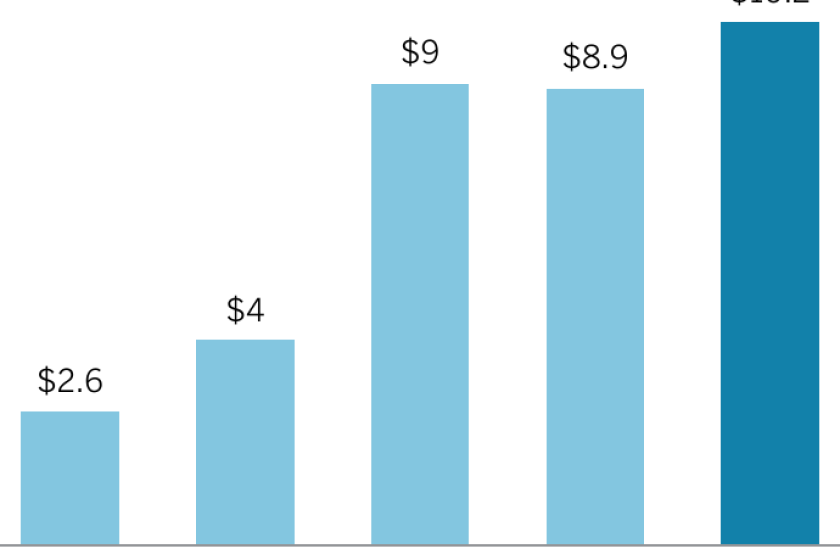Column: Zelensky is coming to Washington to ask for more Ukraine aid. Congress should say yes

- Share via
WASHINGTON — After three months of grueling combat against Russian troops, Ukraine’s summer offensive is finally showing results — but not the dramatic breakthrough Ukrainians and their supporters in the West hoped for.
The Ukrainians’ goal was to penetrate Russia’s heavily fortified defenses in southern Ukraine and cut the main roads between Russia and Crimea. They fought through the first of three Russian lines in late August, and they’re now assaulting the second.
That’s progress, but far short of where they wanted to be.
Think political ads were hard to escape last time around? Spending is about to take another major jump upward, the leading tracker of ad spending projects. California is leading the way even though it’s not a swing state.
It’s been “a breach, but not a breakthrough,” said Michael Kofman, a military analyst at the Carnegie Endowment for International Peace, who has made several visits to the battle zone. Each day’s progress “is measured in the hundreds of meters,” not kilometers or miles, he said. “It’s kind of a slugfest.”
Ukraine’s advance could still pick up speed before its ammunition runs out and winter sets in, Kofman added. Even so, it’s clear that this war will continue well into 2024, and probably beyond.
Ukraine’s leaders are determined to keep fighting, since the alternative is to see their country taken over by Russia’s Vladimir Putin. But their army has not advanced far enough to make Putin decide to cut his losses.
He’s betting that the United States and its European allies will tire of sending money and weapons to Kyiv.
Another reason for Putin to keep fighting is the prospect that Donald Trump might return to the White House. Trump praised Putin’s invasion last year as “genius” and has claimed that if he were elected, he would end the war “in 24 hours,” which sounds like pulling the plug on Ukraine.
So it will take another year of fighting plus a presidential election before Putin even considers negotiations.
Meanwhile, Ukraine needs help from the United States and Europe to keep fighting. Ukrainian President Volodymyr Zelensky will visit Washington this week to meet with President Biden and members of Congress.
One of his top requests to Biden will be for the U.S. Army Tactical Missile System, also known as ATACMS (pronounced “attack ’ems”). The missiles’ 190-mile range would allow Ukraine to hit Russian bases, equipment and ammunition well behind the front lines.
The Pentagon has rejected the request for reasons including fear that Ukraine might use ATACMS against targets deep inside Russia, potentially provoking a superpower crisis. But in recent weeks, unnamed administration officials have said Biden is close to sending the missiles, a decision that could nudge other countries to send them too.
But the ATACMS aren’t likely to arrive in Ukraine soon enough to affect this summer’s offensive. Even then, they might not have made a decisive difference.
“There’s no silver bullet that’s going to transform the situation,” said Alexander Vershbow, a former U.S. ambassador to Moscow. “But ATACMS should be useful during the winter in impeding the Russians’ efforts to rebuild their fortifications.”
Meanwhile, Biden is asking Congress for another $24 billion in military and humanitarian aid for Ukraine. The proposal has drawn noisy opposition from pro-Trump Republicans, but with support from GOP hawks and Democrats, it’s likely to pass after vigorous debate.
Polls suggest that most voters support continued aid to Ukraine, but Republicans are increasingly opposed. A CBS News poll this month found that 54% of Americans favor sending more weapons to Kyiv, but 61% of GOP voters disagree.
It’s understandable that many Americans are tired of seeing taxpayer dollars spent on a faraway war. The United States has already sent Ukraine more than
$50 billion in military aid.
So Biden should make a clearer case that helping Ukraine is in the U.S. national interest, not merely an act of charity.
The president and his aides often cite a somewhat abstract principle to make their case: that big countries ruled by autocrats should not be allowed to invade their neighbors and seize territory.
But the stakes in this war also come down to realpolitik — or, if you’d like to stick to English, harsh reality. A Russian victory in Ukraine would be a disaster for the United States, one even more damaging than our chaotic withdrawal from Afghanistan.
It would make Putin the strongman of Eastern Europe, empowered to intimidate his neighbors with threats of more invasions.
And it would make Russia’s three-way alliance with China and North Korea a powerful axis of autocrats, reaching deep into Asia.
The choice for the U.S., in short, boils down to abandoning Ukraine and handing Putin a victory, or giving Ukraine a chance to keep fighting until Putin agrees to negotiate a reasonable peace.
Those may not be palatable choices, but foreign policy is like that most of the time.
And, as Zelensky said last week: “It’s not a movie with a happy end.”
More to Read
Get the L.A. Times Politics newsletter
Deeply reported insights into legislation, politics and policy from Sacramento, Washington and beyond. In your inbox three times per week.
You may occasionally receive promotional content from the Los Angeles Times.












